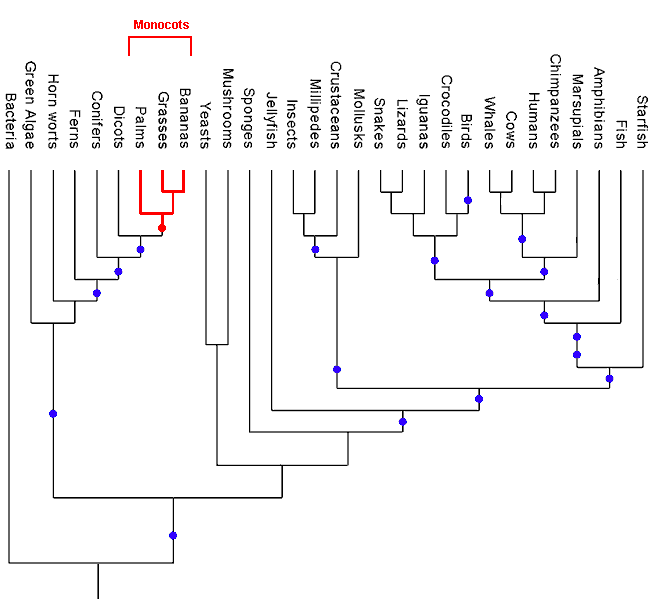This is one of the most fundamental concepts which need to be understood if you want to properly grasp the evidence for evolution. It describes the structure of the pattern of biological diversity produced by an evolutionary process. Evolution is the only process ever proposed which predicts and explains such a pattern.
The nested hierarchy is a consequence of the way in which genetically heritable traits are transmitted from generation to generation. For an illustration, see the following:
“NGT” represents a point at which a new genetic trait is introduced to a population which through natural selection comes to be spread throughout that population to the point where it reaches fixation in the genome. From that point on it will be heritable by all the future generations of that population. Such an event can occur at any time, in any group, but due to the nature of biological reproduction and genetic heritability it can be propagated only “downstream” of the point at which it is introduced. So, the earlier in the process a new trait is acquired, the wider a cross-section of the final population it will be present in. Any traits acquired after that point will be found grouped into smaller and smaller cross-sections of the population and always completely contained within the groupings of earlier acquired traits.
For example, let's say that trait "D" up there was the introduction of, say, a specific alteration to the eye of one species that significantly improved it's visual acuity. That species up top on the other hand, developing along that path that leads to them having traits "A" and "F"... their eyes suck. Well, they're out of luck. Because that new trait for improved vision is only able to be passed on through inheritance so they're not getting it. It can only propagate downstream in the process.
To contrast, if we were examining the products of a common design process we not only could, but would expect to see such outcomes all the time. If while working it’s way along those branching design paths a designer came up at some point with that “D” trait and noticed… “hey, this works better than anything I’m using over on that “AF” development line” then of course any designer would utilize that knowledge in his other designs. For example: The human eye vs. the octopus eye. The eyes on an octopus are far superior in design to our eyes. Their optic nerves attach in a manner which does not produce a blind spot in their vision, that same attachment anchors their retinas, and because all the nerve connections come in through the rear of the eye they do not degrade visual acuity. In our eyes the optics nerve pokes through the back of the eye causing a blind spot which our brains must constantly imperfectly correct for, because our retinas are not anchored by the nerve attachments a sharp blow to the head can detach them, and because the nerve attachments are in the front they get in the way of incoming light screwing up our visual acuity. Any designer who knew how to build an octopus eye would know there was a better way to design an eye than that. The evidence indicates however that the octopus evolutionary path simply experienced optical development which was superior to anything that occurred in human ancestry after the two branched off from each other… and after that branching occurred there was no way in which to share the advances experienced on one line with the other. Not within an evolutionary framework.
Now, what do we see when we look at the pattern of biological diversity present today? Here’s an example using 30 major examples (animated gif, modified from the universal phylogenetic tree diagram in Doug Theobald’s “29 evidences for macroevolution”. Takes a little while to cycle through.)
As you can see, a distinctive nested hierarchical pattern, precisely what is predicted and explained by an evolutionary development process. No other process has ever been proposed that would produce that particular distinctive pattern. I am quite aware that someone can now come along and say “well a designer could have designed it so that it made that pattern on purpose” but the point is that it doesn’t matter what pattern was found you could always say the same thing. It’s an unfalsifiable hypothesis... which is another way of saying a completely useless answer. It tells us nothing. At all. It’s the same as saying “I hereby predict we will find… something!” and then when we do find “something” pointing out how the findings are completely consistent with your “theory”.
Evolution on the other hand makes a very specific prediction which is a necessary consequence of the mechanisms it describes… a prediction which, if the theory were wrong, could very easily be disproven. That prediction is however specifically confirmed by the data. That’s considered very powerful evidence that a theory has it right.
What is considered even more powerful evidence is that the fossil record overlays the nested hierarchical pattern created by the phylogenetic groupings of modern species which is shown above to an extremely high degree of accuracy. The innermost (and therefore within an evolutionary framework, latest to be introduced) groupings of genetic characteristics are the latest to have representation within the fossil record… etc…
This excellent cross-correlation of data between modern biological diversity and the fossil record is known as the twin nested hierarchy.
5.29.2010
Subscribe to:
Post Comments (Atom)




No comments:
Post a Comment